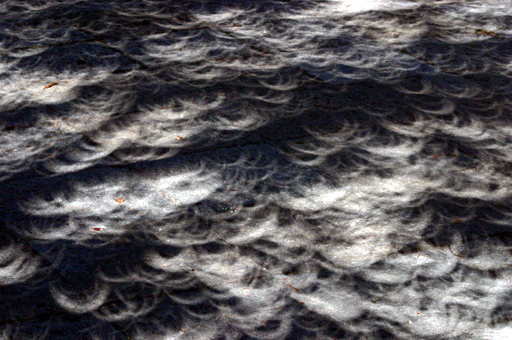The "PINHEAD" Effect
Many people are familiar with
"pinhole" projection and how, with a partial eclipse creates images of
the solar crescent, E.g., naturally occurring with sunlight shining
through the gaps between tree leaves, as in this example:

from the 2005
annular solar eclipse in Spain.
I have found, however, that not so many people are familiar with
one of the aspects of diffraction by a circular aperture for anything
but a point source. If you take a circular aperture that is
angularly large in extent compared to an illuminating extended (e .g.,
also circular) source, diffraction by the aperture will create a DARK
image of the illuminating source in the center. Not very dark
(contrast is weak) but for the right ratio of sizes this can be seen
visually, in particular if the source is the Sun, with angular diameter
about half a degree.
Eclipse chaser John Beattie has dubbed this the "Pinhead" effect
(to differentiate from the pin hole effect) and demonstrates with a
combined pinhole and pinhead projection card during the partial phase
of the 2012
annular eclipse in the photo below.

In the picture on the left side,
John is holding his "pin head + hole" projection card in his unseen
out-stretched right hand. The card is just cardboard stock with
four small pinholes - one each near each corner, and a large (about an
inch) hole in the center -- to create the "pin head" image. The
images are projected onto a white card you see in his left
hand. With the Sun in partial eclipse, the diffracted pin
head image is a DARK solar crescent. This is a bit hard to see in
the original photo due to the shallow contrast. (If you drag the image
around display, as it is moving it may be easier to see). In the
image on the right I have applied ONLY a digital contrast re-stretch
differently in the outer and inner parts on the image - to make this
inverted (dark) crescent more readily seen. Otherwise no monkey
business.
I often see eclipse chasers making pinhole projectors, but not
often pin head projectors, and I suspect the effect may not be as
commonly known to some. So, here it is - for all the "pinheaded"
eclipse chasers out there.
My thanks to John Beattie for this demonstration.
-----------------------------------------------------------
RETRUN to Glenn
Schneider's Home Page


